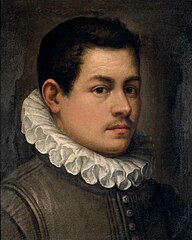
Born: November 3 1560, Bologna, Italy
Died: 15 July, 1609 (aged 48)
Period: Baroque
The Life of Annibale Carracci
Annibale Carracci, born in Bologna, Italy, in 1560, was a pivotal figure in the Baroque period of art. He, alongside his brother Agostino and cousin Ludovico, founded the influential Accademia degli Incamminati in Bologna, which played a significant role in the development of the Baroque style, emphasizing the importance of both nature and the study of the great masters of the Renaissance.
Annibale’s early works were in Bologna, where he produced numerous altarpieces and devotional works, notable for their realism and emotional depth. His style was a reaction against the artificiality of Mannerism, seeking instead to bring a renewed sense of naturalism and vitality to painting. This approach was evident in works such as the frescoes in the Palazzo Fava and the striking “Butcher’s Shop.”
His career took a decisive turn when he was invited to Rome by Cardinal Odoardo Farnese in 1595. In Rome, Carracci embarked on what would become his masterpiece, the decoration of the Farnese Gallery. This work, completed with the help of Agostino and a team of assistants, is a series of mythological and allegorical frescoes that showcase Carracci’s brilliant handling of space, light, and narrative, combining grandeur with an attention to detail and emotional resonance.
The Farnese Ceiling was revolutionary, marking a departure from the Mannerist style that had dominated Italian painting. Carracci’s work on the ceiling combined the dynamism and energy of High Renaissance masters like Michelangelo with the clarity and luminosity found in the works of Raphael and Titian. This synthesis of styles was groundbreaking, influencing the direction of Baroque art and paving the way for future artists, including Peter Paul Rubens and Rembrandt.
Despite his success, Annibale’s later years were marred by melancholy and ill health, partly due to the immense physical and mental strain of his work in the Farnese Gallery. His output slowed, and he focused mainly on small-scale works and drawings. Annibale Carracci passed away in Rome in 1609, leaving behind a legacy that would greatly influence the Baroque movement. His emphasis on the observation of nature, combined with a reverence for the art of the Renaissance, helped to shape the future of European painting.
Annibale Carracci’s contribution to art lies not only in his paintings but also in his approach to teaching and theory. By advocating for a balanced study of nature and the works of past masters, he helped to formulate a vision of art that was both forward-looking and deeply rooted in tradition. His work remains a testament to the transformative power of observing the natural world and the human condition.
Annibale Carracci’s Notable Works
Annibale Carracci’s oeuvre is a testament to his ability to blend the naturalism of the High Renaissance with the emotional intensity and dynamism that would come to define the Baroque. Through his paintings, frescoes, and teachings, Carracci left an indelible mark on the world of art, influencing generations of artists to come.
- The Loves of the Gods (Farnese Gallery Frescoes) – A monumental series of mythological frescoes in the Palazzo Farnese, Rome, showcasing Carracci’s mastery in creating illusionistic space and his innovative use of light and shadow.
- The Beaneater (Mangiafagioli) – A genre painting that depicts a simple, everyday scene with remarkable naturalism and detail, highlighting Carracci’s interest in portraying real life.
- Domine, Quo Vadis? – A religious painting that depicts the apocryphal story of Saint Peter meeting Jesus on the road outside of Rome, notable for its emotional depth and dramatic use of perspective.
- Flight into Egypt – This work illustrates Carracci’s ability to infuse a traditional biblical narrative with a sense of tenderness and human warmth, set within a beautifully rendered landscape.
- Assumption of the Virgin Mary – Located in the Cerasi Chapel of Santa Maria del Popolo in Rome, this painting is celebrated for its vibrant colors and dynamic composition, illustrating Carracci’s impact on religious art.
- Pietà – A deeply moving work that reflects Carracci’s skill in conveying human emotion and spiritual depth through the depiction of Mary mourning over the dead Christ.
- Butcher’s Shop – An early work that demonstrates Carracci’s remarkable talent for realism and detail, depicting a butcher’s shop with lifelike precision.
- Venus, Adonis, and Cupid – A mythological painting that exemplifies Carracci’s skill in composing complex narratives, filled with emotion and beauty.
- The Choice of Hercules – An allegorical work that represents Hercules at a crossroads between Vice and Virtue, showcasing Carracci’s ability to convey moral themes through classical mythology.
- Saint John the Baptist in the Wilderness – A testament to Carracci’s mastery in landscape painting, this work combines a detailed portrayal of the saint with a lush and expansive background, reflecting the artist’s innovation in integrating figure and environment.